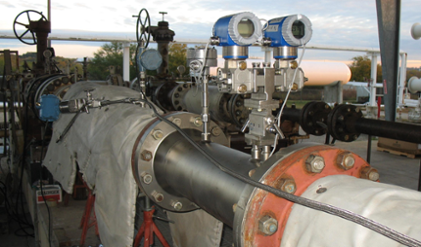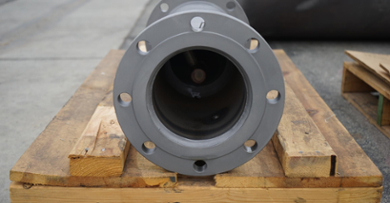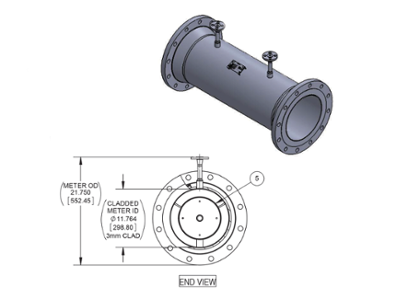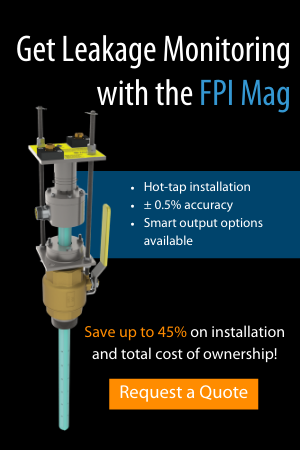Aimee Davis and Ken Quandt: Making Meters Work Smarter and Harder at McCrometer
This article was originally published in the September 2021 issue of Irrigation Leader.
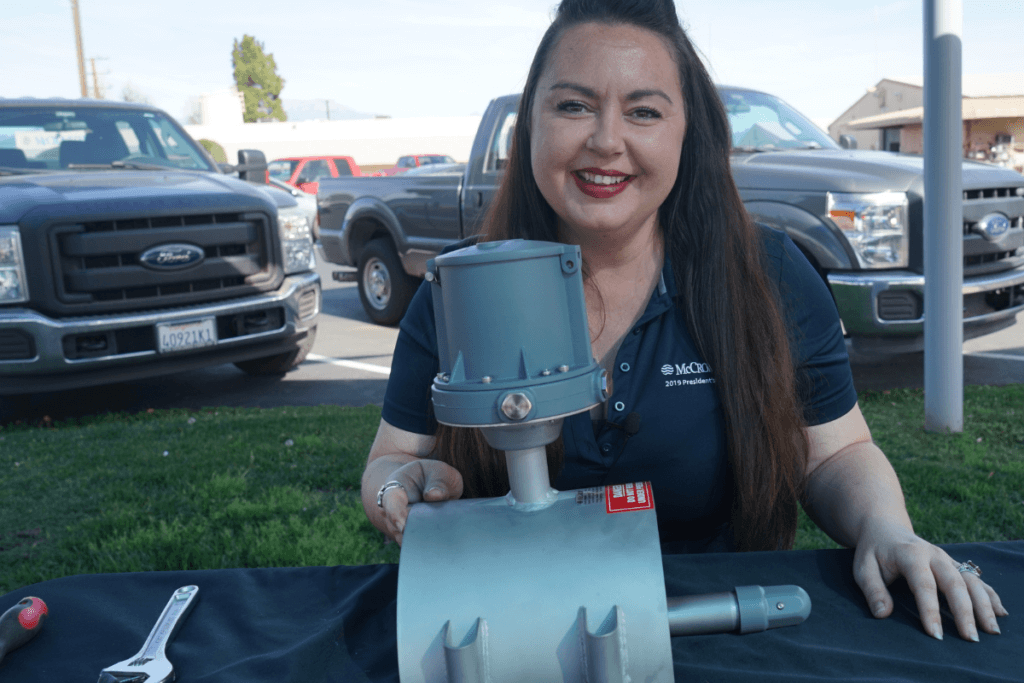
Aimee Davis describes the installation process for the McMag2000 in this still from McCrometer’s instructional video.
McCrometer has long been a stalwart in the irrigation industry. Its innovative meter products allow irrigators to properly measure water efficiently and cost-effectively. As new technologies and customer demands have emerged, McCrometer has continually innovated in order to keep providing water users with high-quality yet affordable products. The company continues to do precisely that with its new mag meter products. In this interview, Senior Product Manager Aimee Davis and Market Development Manager Ken Quandt tell Irrigation Leader about why McCrometer developed the new mag meters, how it innovated to optimize them for customers’ needs, and the meters’ appeal to both irrigation and municipal water users.
Irrigation Leader: Please tell us about your backgrounds and how you came to be in your current positions.
Aimee Davis: I am a senior product manager at McCrometer. I’ve been with the company for quite a long time. I started working with the company back in the year 2000. I’ve had varying roles in operations and quality management and eventually found myself in marketing and product management. In February 2021, I was promoted to senior product manager.
Ken Quandt: I work in market development for McCrometer. I’ve been with McCrometer almost 15 years now. I started out working for Great Plains Meter, which was the Midwest ag rep for McCrometer. Then I went to work for McCrometer as a regional sales manager, worked in marketing for a while, and did a lot of government relations work. Now I’m back on the sales team, and I work with all the ag regional sales managers on special district projects, irrigation districts, and conservation districts. I also develop grant proposals with some of our district partners.
Irrigation Leader: Please introduce the company and its product lines.
Aimee Davis: McCrometer was founded in 1955. The company first started out with our McPropeller meter, which was for the agriculture market. For a long time, we stayed in the agricultural market with quite a few different products. In 1985, we came out with the V-Cone meter, which allowed us to start playing in other markets, such as energy and industrial. Today, we are in all those markets as well as the municipal sector. We have varying ranges of product lines, but I’d group them into a few categories. We have propeller, or mechanical, meters. We have electromagnetic meters, both full bore and insertion types. We also have our differential pressure meters: our V-Cone and Wafer-Cone. And then we have accessories such as Connect and FlowConnect, which allow customers to get meter readings sent directly to a phone, desktop, or laptop through telemetry.
Irrigation Leader: Why did McCrometer develop the new McMag2000 meter, and how does it differ from your other mag meters?
Aimee Davis: We started seeing a trend of agricultural customers wanting meters with no moving parts. They also wanted something that was at price parity with what they were used to paying for propeller meters. However, the prices of most mag meters are quite a bit higher than those of propeller meters. Working with our research and development (R&D) team and a few others, and we tried to offer the farmers and irrigators an affordable, easy-toread meter with a similar look to the McPropeller. The new McMag2000 meter uses the same saddle as the McPropeller. That makes it easy for customers who want to shift to mag meters to retrofit. They can buy a kit and easily build it in the field themselves. We have a YouTube video that shows them how to do it step by step.
We have a patent pending on the sensor. It has dual electrodes and takes the reading from the center of the flow column. That improves the signal distribution and ensures better accuracy. It’s a great little sensor. It has a modular design. To me, that’s really what makes it different, not only from our other mag meters but from the other mag meters in the marketplace. The modular design allows it to be fully serviceable in the field. Although it is modular, it still has no moving parts, just like other mag meters, meaning users need to do fewer repairs. One of the things that our customers love about the McPropeller is that they’re actually able to maintain them in the field, which reduces downtime. This is the first mag meter that lets them do that. The sensor and converter can be easily replaced, and of course, we have in-field batteries, so they can be replaced as well. Another great thing that makes the McMag2000 different from any other meter is that it can partner with veins and flow straighteners. That drastically reduces straight-run requirements and eliminates the need to repipe customers’ systems when they switch to a different technology. We wanted to give customers a true, direct replacement for the McPropeller meter for when they were ready to make the jump to the mag technology.
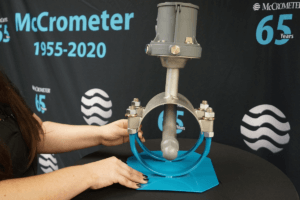
A view of the new McMag2000.
Irrigation Leader: How did you keep the price of this meter down?
Aimee Davis: We built all of it in house, including the sensors and the electronics, and then we used the saddle we already use for the McPropeller. The converter housing is a different color, but otherwise it’s exactly like the housing for our McPropeller digital registers. Using the same housing and saddle as we do for other products allowed us to keep our costs down, and we pass that saving on to our customers. Ensuring price parity was a major motivator for the for the R&D team, which meant we had to figure out a way to take mag meter technology to the next level while keeping the cost low.
Irrigation Leader: In general, what are the advantages of mag meters over propeller meters, and why might current users of propeller meters want to upgrade?
Aimee Davis: Customers really want to get away from moving parts. The more moving parts there are, the more likely it is that an issue may arise. Mag meters have no moving parts at all—they just have electrodes sending the signal into the pipeline and a converter doing the correlation to determine the flow rate. They require less maintenance. However, when most mag meters do require maintenance, they have to be shipped back to the factory or taken to a certified service provider. The McMag2000 is the first mag meter that does not require that. It keeps downtime low, which was one of the things people liked about the McPropeller.
Ken Quandt: The other advantage to a meter like this is that it is easy to integrate into the irrigator’s system and to make it a sensor. It has the built-in ability to send a pulse signal into a pivot panel or a telemetry system so that users can make better use of the meter as a management tool. A lot of farmers want to integrate the meter into the pivot panel so that they can have a better handle on how much water they’re applying. A meter like this has a built-in pulse-output technology that can be integrated into their systems much more easily. Irrigation is getting more technologically advanced, and this helps farmers integrate meters into their systems.
Irrigation Leader: Would you tell us more about the retrofit process?
Aimee Davis: The retrofit is pretty quick and easy. I put together a YouTube video where I walk users through the process. The video is about 7 minutes long, and a user could probably get it done in less than 20 minutes, including the time it takes to stop and look at the instructions. The user has to take the bearing housing off the ell of the pipe that comes off the saddle, unscrew the bearing housing, screw in the sensor, and then plug the ethernet cable that connects in through the ell of the pipe into the sensor. Then, after a little mounting of the electronics, it’s good to go.
Ken Quandt: The modular design that Aimee mentioned is a new philosophy for a meter like this. Just the other night, I was talking to a landowner in Aurora, Nebraska, who has a mag meter from a competitor that he put in 5 years ago. Now, it has failed on him, and he can’t repair it. If he had a meter like the McMag2000, he could replace the sensor or converter and he’d be back in business. Unfortunately, he doesn’t have that option—he has to replace the whole meter.
Aimee Davis: On our website and in our brochure, you can see the exploded diagram for the McMag2000’s modular design. You can also see the converter detached from the saddle, the U bolts, and the sensor. It’s got an ethernet cable. Users can buy the sensor by itself or buy the kit, which includes the converter and the sensor. If a customer wanted to, they could even keep that on the shelf in case they experienced any issues down the road.
Irrigation Leader: Is this product appropriate for pretty much anybody who wants to measure flow in a pipe, or is there something that makes it particularly appropriate for agricultural users?
Aimee Davis: We designed the McMag2000 with farmers in mind mostly because we saw the shift from the McPropeller, which is popular with irrigators. That’s not to say that we haven’t sold them for some municipal applications as well. We just recently extended the line sizes we offer. At launch, we offered options from 4 to 12 inches. Now we offer 14- and 16-inch options for those surface water applications, which may be of interest for municipal users. We may also launch another configuration in addition to the saddle configuration. I have some beta models of top-plate configurations out in the field; those will appeal to municipal users who like the top-plate configuration with our propeller meters and are interested in moving to mag meters without having to repipe their whole systems. Supplying additional configurations for this mag meter technology is something we’re focusing on.
Ken Quandt: People always used to say that if someone was irrigating with good, clean groundwater, nothing was more efficient and economical than a McPropeller. But many people irrigate with dirty water rather than good, clean groundwater. There are surface water irrigation districts with sediment and vegetation in the water, which creates issues with mechanical meters, props, and bearing assemblies; this is a good meter for applications like that.
Irrigation Leader: Is there anything else you would like to add?
Aimee Davis: The other thing that was important when we were designing this product was durability. Customers have come to expect a robust product from us, and we’re happy that they do. We wanted to make sure that this had a long product life cycle, and it did so well in testing that we were able to offer a 5-year warranty on it. That doesn’t just cover the batteries; it covers the converter, the sensor, and the hardware. It’s a complete, bumper-to-bumper guarantee for 5 years. I think that is important to customers making a purchase for a farm.
Ken Quandt: I like to describe this meter as a mag meter that fits in the footprint of a propeller meter. This creates a good opportunity for customers to upgrade from the mechanical propeller meters they have used in the past. They don’t have to worry about taking out the veins they have from their propeller meters. Customers can calibrate the meters specifically to the veins that are already in the pipes. It’s a direct replacement for what they had before, and it’s much easier to integrate this meter into their existing system.
Aimee Davis is a senior product manager at McCrometer. She can be reached at aimeed@mccrometer.com.
Ken Quandt is a market development manager at McCrometer. He can be reached at kenq@mccometer.com.
Related Posts
Featured Posts
3 Reasons Why Budget-Focused Farmers Invest in Integrated Telemetry
Allocating budget to flow technology may seem unjustifiable when funds are tight; flow meters and their electronics may already be installed, giving no reason to replace or add additional units when the current solution is in fine working condition. However, flow...
Small Package, Big Impact: The Importance of Desiccant Cartridge Maintenance
You’ve likely seen a desiccant cartridge, in the form of the small silica gel packet accompanying food products, or the activated carbon packet at the top of pharmaceutical bottles. It’s also commonly used in electronics and near sensors, especially for...
Meeting BABA Compliance and Expanding Opportunities
Content Recorded and Published at WEFTEC in October 2024 In this episode of The Water Online Show: On Location, (now former) McCrometer President Pete Oveson dives into the company's story and recent developments shaping its future. He begins with an overview of...
Request More Information

